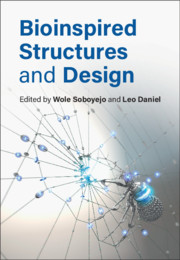Book contents
- Bioinspired Structures and Design
- Bioinspired Structures and Design
- Copyright page
- Contents
- Contributors
- Preface
- Part I Materials
- Part II Structures
- 5 Bioinspired Underwater Propulsors
- 6 Bioinspired Design of Dental Functionally Graded Multilayer Structures
- 7 Bionic Organs
- 8 Bioinspired Design for Energy Storage Devices
- 9 Bioinspired Design of Nanostructures
- Part III Natural Phenomena
- Index
- References
5 - Bioinspired Underwater Propulsors
from Part II - Structures
Published online by Cambridge University Press: 28 August 2020
- Bioinspired Structures and Design
- Bioinspired Structures and Design
- Copyright page
- Contents
- Contributors
- Preface
- Part I Materials
- Part II Structures
- 5 Bioinspired Underwater Propulsors
- 6 Bioinspired Design of Dental Functionally Graded Multilayer Structures
- 7 Bionic Organs
- 8 Bioinspired Design for Energy Storage Devices
- 9 Bioinspired Design of Nanostructures
- Part III Natural Phenomena
- Index
- References
Summary
In recent years, there has been considerable interest in developing novel underwater vehicles that use propulsion systems inspired by biology [1,2]. Such vehicles have the potential to uncover new mission capabilities and improve maneuverability, efficiency, and speed [3,4]. Here we will explore the physical mechanisms that govern the performance – especially swimming speed and efficiency – of propulsive techniques inspired by biology. We will also show that we can translate the understanding we have gained from biology to the design of a new generation of underwater vehicles.
- Type
- Chapter
- Information
- Bioinspired Structures and Design , pp. 113 - 139Publisher: Cambridge University PressPrint publication year: 2020
References
- 7
- Cited by

